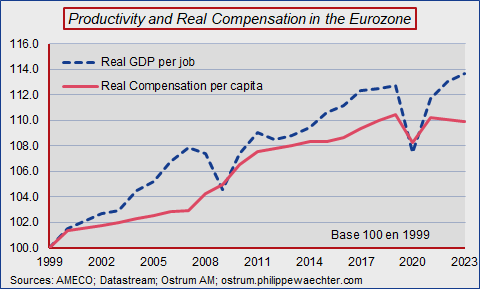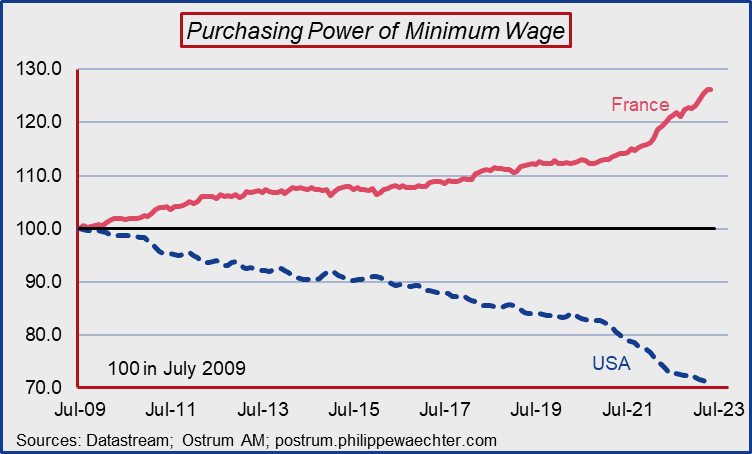The European Commission has validated a directive on the concept of a decent minimum wage. It is defined as a measure that allows an employee to live off his salary but also to participate in social and cultural life. It is not a measure of a living wage. It is also a measure that evolves over time and is not set in stone as minimum wage rates set by governments can be. This notion that European states will have to transcribe without it being compulsory within two years, from October 2022, also makes sense because inflation quickly erases the purchasing power of employees.
* Comment made and edited from an intervention at the Annual Conference of EELA (European Employment Lawyers Association) on June 9 in Bucharest.
The question of wages is necessarily raised when the economy is experiencing a period of high inflation. For low wages, high inflation is a source of social fragility. A salary that is too low only allows participation in social and cultural life in a period of price stability. On the other hand, high inflation forces us to arbitrate in spending and this cuts off social and cultural activities. The salary then looks more like a living wage than an ability to live a full life.
The issue of wages is therefore very acute in times of inflation. Nevertheless, at the macroeconomic level this question has been asked for a while. Wages at the European level have not evolved like labor productivity, whereas this real wage should have a pace consistent with the contribution of the labor factor to production. The graph reflects this. This gap suggests a catch-up so that the European economy finds a balance that can be sustained over time.
Commission proposal on a decent minimum wage
It is in this context that in 2020, the European Commission made a proposal for a decent minimum wage. This would make it possible to catch up while limiting the risks of poverty and improving European solidarity. This is not the first time that this question has been raised in Brussels, but this time it may have a future. Without it being mandatory, countries have two years to transcribe this directive voted in October 2022.
The Commission puts forward the concept of a decent minimum wage which in Anglo-Saxon countries is known as the Living Wage, or the wage that allows you to live decently. It would be a question of defining a rule on a European scale rather than a level because the countries do not all have the same reference level of prices and wages.
This notion of a living wage is not new. We already find it in Adam Smith but also in Karl Marx. It is then a means of emancipation of the working class.
It can also be seen in the preamble to the founding framework of the International Labor Organization (ILO), which refers to “the guarantee of a salary ensuring suitable living conditions”. Franklin D. Roosevelt will also mention it in his project to establish a minimum wage that goes beyond the living wage.
How to define a living wage?
The living wage can be defined in relation to a salary scale, 60% of the median gross salary, this is the solution adopted by the European Commission.
It can also be defined by a calculation based on observed prices. The Americans and the British chose this method instead.
At MIT (Department of Urban Studies and Planning) or in the United Kingdom (Living Wage Foundation), a sufficiently high salary level is calculated to meet the needs of an individual, a couple alone or with one or more children. The figure thus evolves according to the characteristics of the economy.
This is also why there can be a living wage for each region in the US. The states that refer to it construct their value according to local conditions. In England there is one salary for London and another for the rest of the UK.
This reflects differences in price levels and different situations in accessing housing.
The minimum wage rate does not necessarily adjust
Whatever the method, it also makes it possible to calibrate the salary with reference to the dynamics of the labor market and the evolution of consumer prices. The minimum wage is not necessarily indexed. The minimum wage rate in the US has been set since 2009 at 7.25 dollars. Its purchasing power is only 5.3 dollars in 2023. This is why 30 states have upgraded it to 16.1 dollars in Washington DC.
France indexes its minimum wage on the evolution of average wages but especially on the evolution of inflation when it increases by 2% compared to the last revaluation. The graph traces the purchasing power of the minimum wage rate since July 2009, the last American increase). The purchasing power index for France is 126, while in the United States it is only 71.
In other words, the minimum wage rate may no longer make sense when it is not increased at the risk of penalizing those who are paid at this rate.
Salary and Employment
The interesting point in this proposal is that the Commission no longer considers that wages are an enemy of employment and that macroeconomic adjustment necessarily and mainly involves lowering wages, as was mentioned after the 2008 financial crisis for countries suffering from a substantial external deficit. This is a reductive view of macroeconomic adjustments.
There is no lack of studies to emphasize that the salary is not necessarily the enemy of the job (See David Card and Alan Krueger).
Besides the catch-up effect I mentioned, this initiative is important today for 3 reasons:
- The minimum wage is often lower than this living wage level. This is what I illustrated by maintaining the minimum wage rate at $7.25 in the USA since July 2009.
- It is also a welcome measure in an environment that has become inflationary. The minimum wage does not necessarily have an indexation rule and in fact inflation generates a strong loss of purchasing power.
- During the pandemic, the notion of essential jobs was often mentioned, but this did not translate into a real effect on the remuneration of employees in these essential jobs, probably for lack of explicit reference.
This also has a major consequence, which is the sharing of revenues between companies and the State. If companies pay for marginal productivity, then the additional income necessary to live well results from the action of the State. This is the criticism that was already made at the end of the 19th century by Beatrice and Sydney Webb.
If we talk about Living Wage then it is from the companies that we must start, forcing it to implement the means of higher productivity. This is the basis of what economists call the efficiency wage theory. It is a kind of reversal of the burden of proof which can be interesting.
The European Commission has adopted the following framework:
- The Living Wage would be 60% of the gross median salary (reference to the Kaitz Index, by Hyman Kaitz, who put forward this type of measure). This reference is on the median salary rather than the average salary, it is fairer) and on the gross salary to simplify the measurement not conditioned by the social and fiscal policy of the States.
- The other point of the Commission’s proposal is collective wage bargaining. The idea is that when there is collective bargaining, the risks of poverty are more limited.
On a broader level, the labor market, beyond this proposal, is changing significantly. The change in the global equilibrium and the form of globalization will have a major effect on wage dynamics.
In the recent phase of globalization, which was accentuated with the arrival of China within the World Trade Organization in December 2001, the labor market has lost some of its bearings.
Indeed, the labor factor is not very mobile while capital can be very mobile. This has translated globally into a race to lower corporate tax rates to attract investment and business.
The counterpart is that employees have found themselves penalized by the expansion of the job market. Globalization made it possible to create competition between labor markets, particularly for low-skilled people, through a movement of capital. This is an argument that was taken up by Joe Biden in the implementation of his new industrial policy via the Inflation Reduction Act.
The new configuration results in a more inward looking economy. We are talking about the relocation of activities, reindustrialization, economic security or self-sustaining growth. The major economic zones will be more turned towards themselves. Consequently, the labor market becomes more local and the bargaining power of employees will increase. This becomes consistent with the initiative of the European Commission and the theme of a living wage.








